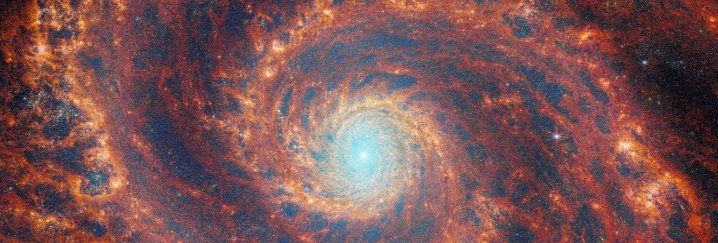A new image from the James Webb Space Telescope shows a stunning view of spiral galaxy M51, also known as the Whirlpool Galaxy, a galaxy so picturesque it is designated a grand-design spiral galaxy for its prominent, clearly defined spiral arms. The image shows off these arms in their full beauty, reaching out from the galactic center and captured in the infrared wavelengths to show off their structure.
The image was taken using two of Webb’s instruments operating in different parts of the infrared: the Near-InfraRed Camera (NIRCam) and the Mid-InfraRed Instrument (MIRI).

In addition to this image, which shows a view combining data from both instruments, Webb scientists also released a slider image that shows NIRCam data on one side and MIRI data on the other, so you can compare the views captured by each instrument. NIRCam is able to capture the signature of of ionized gas swirling around the galaxy’s center, visible as red in the NIRCam image, while MIRI was able to capture the intricate filament structure of cooler gas in and around each of the spiral arms.
The Whirlpool Galaxy is located 27 million light-years away in the constellation Canes Venatici, and it has an unusual relationship with its neighbor, the dwarf galaxy NGC 5195. Typically, when one galaxy passes close to another, then one or both can become gravitationally distorted, and be pulled out into an irregular shape. However, in this case, the nearby dwarf galaxy may have had the opposite effect and have contributed to the Whirlpool’s orderly appearance.
Observations from the Hubble Space Telscope suggest that the dwarf galaxy passed behind the Whirlpool, gliding past without distorting any of its arms. The gravity of the smaller galaxy may still have an effect on the Whirlpool, however, by increasing waves of material that fluctuate within the galaxy’s disk. These waves create dense clouds, which collapse to form new stars, and the radiation from these stars illuminate the arms and make them more prominent.
Editors' Recommendations
- James Webb images capture the galactic winds of newborn stars
- The expansion rate of the universe still has scientists baffled
- This famous supernova remnant is hiding a secret
- See 19 gorgeous face-on spiral galaxies in new James Webb data
- James Webb snaps a stunning stellar nursery in a nearby satellite galaxy




